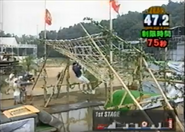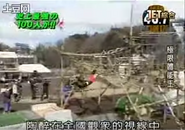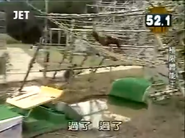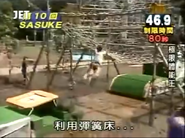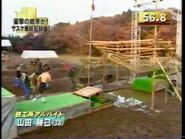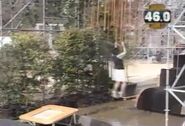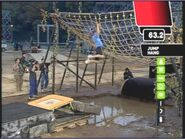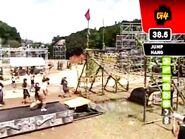No edit summary Tag: Source edit |
Tag: Source edit |
||
| Line 302: | Line 302: | ||
</gallery> |
</gallery> |
||
| − | ==External Links== |
||
{{Sasuke Obstacles}} |
{{Sasuke Obstacles}} |
||
| + | {{KUNOICHI Obstacles}} |
||
{{American Ninja Warrior Obstacles}} |
{{American Ninja Warrior Obstacles}} |
||
[[Category:SASUKE obstacles]] |
[[Category:SASUKE obstacles]] |
||
Revision as of 13:35, 3 December 2020
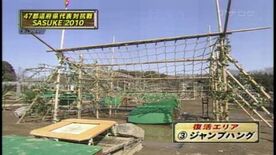
Jump Hang, SASUKE 25
The Jump Hang (ジャンプハング) was a First Stage obstacle introduced in SASUKE 5, after Akiyama Kazuhiko's kanzenseiha in SASUKE 4, which debuted as the fourth obstacle, replacing the Maruta Kudari from the previous tournament.
Competitors had to leap forward off of a trampoline to grasp the underside of a cargo net. After that, they either climbed over it and rolled down the cargo net or climbed under it and risked touching the water.
The obstacle ultimately proved to be one of the most difficult obstacles in SASUKE history, as every All-Star and most top competitors failed there at least once.
In SASUKE 6 alone, it took out more than fifty competitors, including Akiyama Kazuhiko in his first tournament back since his kanzenseiha on SASUKE 4. Akiyama failed on this obstacle for three tournaments in a row (from SASUKE 6 to SASUKE 8), before finally completing it in SASUKE 10.
In SASUKE 10, the net was slightly placed further away than any other tournaments. Because of that, several competitors who completed the obstacle from the previous tournaments, failed in this tournament, including Takeda Toshihiro and Nagano Makoto.
From SASUKE 14 to SASUKE 15, due to the appearance of the Butterfly Wall, the Jump Hang was moved to the fifth position. In SASUKE 17, it became the sixth obstacle due to the presence of the Maruta Zaka and Circle Slider.
The Jump Hang did not eliminate any competitors in SASUKE 15 and was finally taken out in favor of the Jumping Spider in SASUKE 18, after Nagano Makoto's kanzenseiha in SASUKE 17.
After Urushihara Yuuji's kanzenseiha in SASUKE 24, the Jump Hang returned in SASUKE 25, along with the Rolling Maruta and Circle Slider. However, those three obstacles were removed in the following tournament yet again.
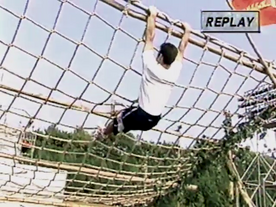
Hatakeda Yoshiaki grabbed the top part of the Jump Hang, SASUKE 6
Although the intent was to grab the net, it was possible to grab the top support of the obstacle. Four competitors did this:
- Hatakeda Yoshiaki in SASUKE 6 (with him being the only competitor to grab the top part of the Jump Hang with both of his hands, while others managed to grab the support with only one hand),
- James Okada in SASUKE 7,
- Kane Kosugi in SASUKE 7, and
- Paul Anthony Terek in SASUKE 17.
Competitors' Success Rate
- All results based on the TBS broadcast and external information found.
| SASUKE | Clears | Attempts | Percentage |
|---|---|---|---|
| 5 | 10 | 76 | 13.15% |
| 6 | 11 | 87 | 12.64% |
| 7 | 17 | 78 | 21.79% |
| 8 | 15 | 22 | 68.81% |
| 9 | 10 | 20 | 50% |
| 10 | 10 | 28 | 35.71% |
| 11 | 17 | 22 | 77.27% |
| 12 | 16 | 28 | 57.14% |
| 14 | 20 | 24 | 83.33% |
| 15 | 19 | 19 | 100% |
| 16 | 24 | 29 | 82.76% |
| 17 | 19 | 27 | 70.37% |
| 25 | 26 | 40 | 65% |
| Total** | 214 | 500 | 42.8% |
- Notes: In a special before SASUKE 15, the completion percentage was said to be (from SASUKE 5 to SASUKE 14, including the SASUKE 13 version found below) 201 clears out of 470 attempts for a percentage of 42.7%. It was unknown how competitors did in each specific tournament, therefore these numbers were not included in the individual tournaments but were calculated into the final overall total.
SASUKE 13 Version
As part of the moderate redesign of SASUKE 13, a series of ropes hanging from the scaffolding replaced the cargo net.
This required different strategy than the former version, with competitors such as Shiratori Bunpei able to clear the obstacle by grabbing the ropes and using their momentum to swing to the platform.
The original version returned in the next tournament.
Its alternative names were Jump Dangle (ジャンプダングル) or Jump Hang (Rope Version) [ジャンプハング (ロープ版)]
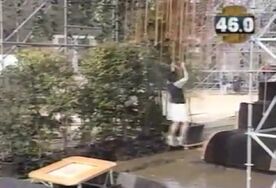
Ueki Shigenori attempted the Jump Hang, SASUKE 13.
Competitors' Success Rate
- All results based on the TBS broadcast and external information found.
| SASUKE | Clears | Attempts | Percentage |
|---|---|---|---|
| 13 | 16 | 26 | 61.54% |
| Total | 16 | 26 | 61.54% |
Jump Hang Kai
In SASUKE 28, the Jump Hang was brought back but modified. It was renamed as the Jump Hang Kai (ジャンプハング改), literally Modified Jump Hang. For unknown reason, the name was reverted back to the original in SASUKE 31.
Instead of jumping to one net positioned perpendicular to the trampoline, two nets were positioned parallel to the trampoline. Competitors needed to jump from the trampoline to either one side and grabbed the front of the net.
From there, they needed to traverse the net (similar to the Net Bridge) to reach the other side. It was also legal to climb inside the net, but doing so wasted a lot of time.
It was replaced by the Double Pendulum in SASUKE 32.
Other Appearances
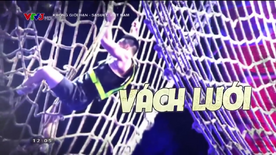
SASUKE Vietnam 4's Jump Hang Kai
On SASUKE Vietnam 4, the Jump Hang Kai (called locally as Vách Lưới) appeared as the fourth obstacle in Stage 1B, replacing the Giant Swing from the past three SASUKE Vietnam seasons. However, unlike in SASUKE, one additional rule was added to the obstacle, in which competitors were not allowed to climb inside either of the cargo nets. If they did so, they would be disqualified.
This obstacle was proven to be extremely easy, compared to its appearance in SASUKE. Since the nets were placed very near to the trampoline, many competitors skipped the trampoline jump by making a long run-up or even just making a standing jump at the starting platform (very similar to the Net Bridge in SASUKE 18). However, it shockingly claimed Hiroshi Miyamoto as the only victim of this obstacle, when his hands slipped at the net after the jump and fell into the water.
Due to its low knockout rate, the obstacle was replaced by the modified Rope Jungle on SASUKE Vietnam 5.
Competitors' Success Rate
- All results based on the TBS broadcast and external information found.
| SASUKE | Clears | Attempts | Percentage |
|---|---|---|---|
| 28 | 12 | 18 | 66.67% |
| 29 | 26 | 41 | 63.41% |
| 30 | 37 | 48 | 77.08% |
| 31 | 34 | 40 | 85% |
| Total | 109 | 147 | 74.14% |
KUNOICHI Version
The original Jump Hang reappeared in KUNOICHI 9 for a brand new reboot, as the fifth obstacle of the brand new RED Stage (First Stage).
Its purpose remained the same, jump using a trampoline far enough in order to reach and grab the net. However competitors could only go under the net instead of above (similar to the Jump Hang used on American Ninja Warrior 6 in Miami and American Ninja Warrior 7 in San Pedro (Military)).
It was removed in the next tournament, in favor of the Double Pendulum, which was coincidentally, the one that also replaced the Jump Hang (Kai) in SASUKE.
Competitors' Success Rate
- All results based on the TBS broadcast and external information found.
| KUNOICHI | Clears | Attempts | Percentage |
|---|---|---|---|
| 9 | 9 | 14 | 64.28% |
| Total | 9 | 14 | 64.28% |
American Ninja Warrior Appearances
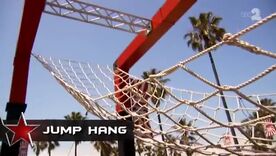
American Ninja Warrior 3's Jump Hang
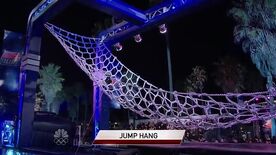
American Ninja Warrior 4's Jump Hang
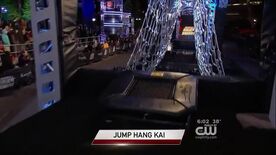
American Ninja Warrior 5's Jump Hang Kai in Denver
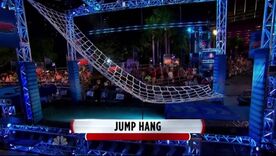
American Ninja Warrior 6's Jump Hang in Miami
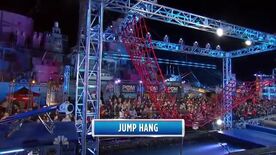
American Ninja Warrior 7's Jump Hang in San Pedro (Military)
The Jump Hang appeared as the fourth obstacle on:
- American Ninja Warrior 3 in qualifying and semifinal,
- American Ninja Warrior 4 in every qualifying region,
- American Ninja Warrior 5 in Denver (Jump Hang Kai version),
- American Ninja Warrior 6 in Miami, and
- American Ninja Warrior 7 in San Pedro (Military), as the second obstacle rather than as the fourth obstacle, with the Monkey Pegs took its place.
On American Ninja Warrior 6 and American Ninja Warrior 7, competitors could only climb under the net (this particular rule made this obstacle more challenging, as competitors tried to stay above the water). Although several competitors failed on this obstacle, it was notable for eliminating:
- Dustin Rocho during American Ninja Warrior 4's Southwest region finals (resulting a ruptured eardrum),
- Brian Orosco during American Ninja Warrior 4's Northwest region qualifiers, and
- Flip Rodriguez during American Ninja Warrior 6's Miami qualifiers (when his posterior touched the water while climbing down the cargo net).
On American Ninja Warrior 7, the netting was modified compared to the one used on the previous seasons, with the end part was raised a few inches higher and the netting being longer.
Other Appearances
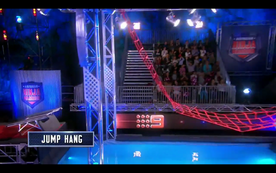
Australian Ninja Warrior's Jump Hang
The Jump Hang has been used on several SASUKE/Ninja Warrior's international formats (with most of them had the same specification and completion rule from American Ninja Warrior 6 and American Ninja Warrior 7), including:
- Ninja Warrior UK,
- Australian Ninja Warrior,
- SASUKE Ninja Warrior Indonesia, and
- SASUKE Vietnam (Jump Hang Kai version).
Gallery
| ||||||||||||||||||||
| |||||||||||||||||||||||||||||


